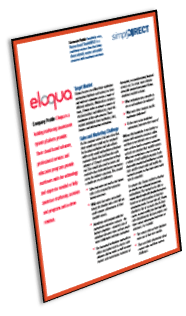 The Internet has revolutionized much of life as we know it. Sharing information and engaging in critical conversations has become more direct, immediate, and yet infinitely more complex. Consider the more sophisticated B2B purchases, for example. The purchase process has actually lengthened now that buyers must do much of their own product research and due diligence. The benefit is that understanding the various options and solutions before they call a sales rep enables buyers to achieve a position of power from which they can negotiate a better deal. Of course, for sellers the opposite is true. The sales cycle has become shorter, average selling prices lower and the ability to negotiate far less. For marketers, dealing with these changes is becoming ever more challenging.
The Internet has revolutionized much of life as we know it. Sharing information and engaging in critical conversations has become more direct, immediate, and yet infinitely more complex. Consider the more sophisticated B2B purchases, for example. The purchase process has actually lengthened now that buyers must do much of their own product research and due diligence. The benefit is that understanding the various options and solutions before they call a sales rep enables buyers to achieve a position of power from which they can negotiate a better deal. Of course, for sellers the opposite is true. The sales cycle has become shorter, average selling prices lower and the ability to negotiate far less. For marketers, dealing with these changes is becoming ever more challenging.
Yet while product research can result in lower prices there is a hidden cost; the time and effort required to research different solutions and engage with peers. Typically the bargaining power gained makes this worthwhile but it’s still time consuming and runs the risk of eliminating vendors whose solutions may be a strong fit but who have only a limited track record with peers and recommenders. Marketers must find ways to simplify the early phases of the buyer’s journey, where most of the research and education takes place, in order to engage with buyers before they produce their short list.
With the increasing volume of online information buyers have already become savvy, independent researchers. They’ve learned how to leverage social media platforms, industry groups, and online communities in order to gain a richer and more independent understanding of the solutions available to them. In parallel, the plethora of technology solutions has exploded. Simple “products” have become commoditized and buyers are bombarded with information about service-based solutions designed to help with their complex business challenges.
As a result:
- The amount of time buyers spend researching a solution prior to talking to sales is increasing.
- The desire to fully understand the options before engaging vendors may lead some to make sub-optimal choices.
- Technology is becoming commoditized and vendor profitability determined more by incidental (add-on services) and incremental (follow-on) factors.
To ferret out the information they need buyers are looking to social media for peer reviews and to thought leaders who can serve as trusted advisors. It’s a great way to reduce purchase risks. But a more subtle reason to ask for recommendations is to simplify the decision making process. Faced with many choices and copious information buyers are becoming fatigued. Eliminating the unknowns helps to make the process manageable.
The implications for marketing are immense. First off, the KISS principle (Keep It Simple Stupid) remains sacrosanct. Messaging – Who is this for? What does it do? Why do I care? – benefits, references, credibility indications and so on, must all be simple, straightforward and powerful. Making your product or solution sound too sophisticated or your sales pitch too complex will lead to a lack of consideration. Yet how do you distinguish your offering from the competition when providing too many details can get you filtered out? Follow these 4 simple rules:
- Keep messaging simple but change the buyer’s mindset by offering unique insights into how your solution helps with critical but unconsidered needs.
- Remember that buying is a journey not a single event. Break your messaging into bite-sized chunks that can be more easily consumed over time.
- Do your homework. Who are the influencers that your target buyers turn to? Make sure they are familiar with your offering so that they respond positively when asked.
- Work to develop trusted advisor status for your own company. Become a resource; curate and provide the information that your prospects need so that they don’t have to research everything themselves, i.e. give the gift of time.
At SimplyDIRECT we help technology vendors research the needs of their target accounts so they can more easily engage with senior-level contacts and have the information necessary to change buyer’s mindsets. To find our more read our Oracle | Eloqua case study. Click the image below to access the download.
What rules do you follow to ensure your content marketing is effective?

